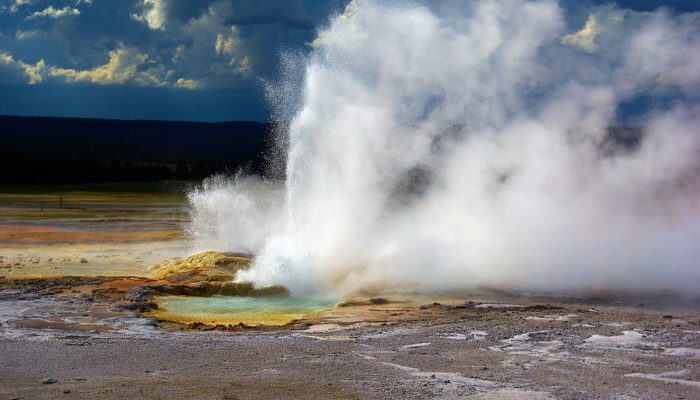
GMPV and The Sustainable Development Goals
In 2015 all United Nations Member States adopted a set of Global Goals, as a universal call to protect our planet, end poverty and ensure that all people can enjoy peace and prosperity. These are called the Sustainable Development Goals – 17 integrated goals aimed at addressing the challenges our society is currently facing considering social, economic, and environmental sustainability.
From decarbonization, to disaster risk reduction and natural resources, geoscience and geoscientists can play a key role in achieving these goals. This blog series will explore how geoscientists, and in particular Geochemists, Mineralogists, Petrologists and Volcanologists, fit into this this framework.
Renewable Energy and Geothermal Energy
Our first blog post in this series focused on mineral resources on sustainable mining, but today we dive into the world of Geothermal Energy with Dr. Nathaniel Forbes Inskip, Research Associate at Heriot-Watt University.
From Affordable and Clean Energy (SDG 7), to Climate Action (SDG 13) and Sustainable Cities and Communities (SDG 11), geothermal energy production is at the forefront of sustainability and low-carbon technologies.
Human societies have a growing need for energy services, and since 1850 fossil fuels have been the main source of energy. The current climate emergency we are facing as a result of this has led to an increased focus being put on renewable energy programs, aiming for a low-carbon, efficient, resilient and sustainable future. Geothermal energy is currently used as a reliable source for electricity and heat in 90 counties worldwide. Utilizing the natural heat produced from the Earth’s interior, the sustainable management and extraction of these geothermal fluids can provide a long term and secure alternative to fossil fuels and greenhouse gas emissions.
The key challenge in this field is to successfully find and extract viable geothermal resources, whilst balancing future innovation and potential environmental risks. With many geothermal systems occurring in a range of geological environments, and a growing demand for greener energy sources, geoscientists have a key role to play.
So how can geoscientists help?
Geothermal systems are the result of the transfer of heat from the core of the Earth towards the surface. Hot springs and fumaroles are a common surface feature of geothermal systems, but many “hidden” geothermal potential resources lack such surface manifestations – geothermal exploration therefore relies on the integrated geological, geophysical and geochemical understanding of these systems. With magmatism being the most efficient way to transfer heat to the shallow crust, many high temperature geothermal systems are found in volcanic areas – see the Iceland hotspot, the Taupo Volcanic Zone in New Zealand, and Indonesia. Nevertheless, geothermal reservoirs have also been found in continental settings and non-magmatic rifts. In these intermediate-low temperature geothermal systems, either heat is produced through radioactive isotope decay and/or water is heated by being circulated along deep fault zones.
“I have always been fascinated by volcanoes, hot springs, geysers and the heat which could be utilised from beneath our feet to heat our homes or converted into electricity”
With a degree in Earth Sciences and an MSc in Renewable Energy, Dr. Forbes Inskip’s ideal research plans would be a combination of both, with geothermal energy being the most obvious choice. After working for a biogas company for a while, he returned to academia.
“Unfortunately when I was looking at starting a PhD there were no funded projects available related to geothermal energy, and so I looked for projects on technologies that relied on similar processes to be successful”. At the same time there was a growing interest in unconventional oil and gas, with several funded opportunities in this field.
“Fracture related processes are important in both unconventional oil and gas production but also in many geothermal energy systems”, says Nathaniel. His PhD research focused on understanding how anisotropy and heterogeneity in shale reservoirs could influence fracture propagation, and the skills that he acquired during his PhD he now applies to his role as a Research Associate on the NERC funded GWatt project (Geothermal Power Generated from UK Granites). Similarly to his PhD project, Nathaniel’s current role is largely lab focused, and he believes that learning about rock mechanics and carrying out rock mechanics experiments has been hugely important in being able to pursue his ambition of working on geothermal energy research.
There are three main geological controls which affect the productivity and viability of a geothermal system to produce energy, and these are heat source and flow; permeability of the geological formation, including faults and fractures, and fluid flow patterns.
Across different geological settings, geothermal reservoirs can be hosted in different rock formations, which in turn play an important role in defining the properties of the reservoir. Being able to characterise and identify volcanic and plutonic rocks, carbonates and sedimentary rocks, and metamorphic and plutonic rocks is a key skill for geothermal exploration.
Another fundamental aspect of geothermal systems is fluid flow. Subsurface geology, faults and fractures in rocks serve as transport channels for geothermal fluids, and being able to identify and locate these structures is important to be able to understand the full potential of a reservoir.
Finally, understanding the geochemical composition of geothermal fluids which carry the heat to the surface is very important for assessing the potential productivity of a geothermal system, as geochemistry can shed light on the origins, circulation patterns, evolution and temperature of geothermal fluids over time.
“I think it is easy to forget that a PhD provides you with so much more than the skills to complete a very specific task […] As a PhD researcher, you essentially become a serial problem solver, setting out to tackle and solve complex problems. To do this you have to be creative, determined and think critically when analysing data or your work. These are qualities that I developed throughout my PhD and have served me well in my current role.”

Dr. Nathaniel Forbes Inskip, Research Associate at Heriot-Watt University, in Porthgwarra – Cornwall.
Great challenges and opportunities
“Geothermal energy is one of the only low carbon technologies that can adequately tackle the de-carbonisation of heating and cooling, as well as providing a reliant base load of electricity in areas where there is significant heat available.”
From magmatic arcs and hotspots, to continental rifts and transtensional pull-apart basins, geothermal systems can be found in a variety of volcano-tectonic settings. Geoscientists are equipped with the key skills in mineralogy, geophysics, structural geology and geochemistry to be able to play a key role in helping to identify viable geothermal resources, and to understand the key geological factors which control these systems.
We asked Nathaniel his thoughts on the role that geoscience and GMPV researchers can play in geothermal energy:
“Some of the most prospective geothermal energy reservoirs are in active volcanic regions, or in areas containing high heat producing granites rich in radioactive minerals. Be it in resource quantification during exploration, or understanding how a reservoir behaves during operation, and everything in between, there are significant opportunities for the GMPV community to help develop this important technology!”.


Pingback: Geochemistry, Mineralogy, Petrology & Volcanology | GMPV Campfires co-hosted with ERE Division: Sustainability Talks! Wednesday 16th June @ 11am CEST
Pingback: Geochemistry, Mineralogy, Petrology & Volcanology | Carbonate Minerals: the Silent Players of Climate Change – Victoria Corcimaru for GMPV for Sustainable Development
Pingback: Geochemistry, Mineralogy, Petrology & Volcanology | GMPV for Sustainable Development – Geohazards and Volcanic Monitoring